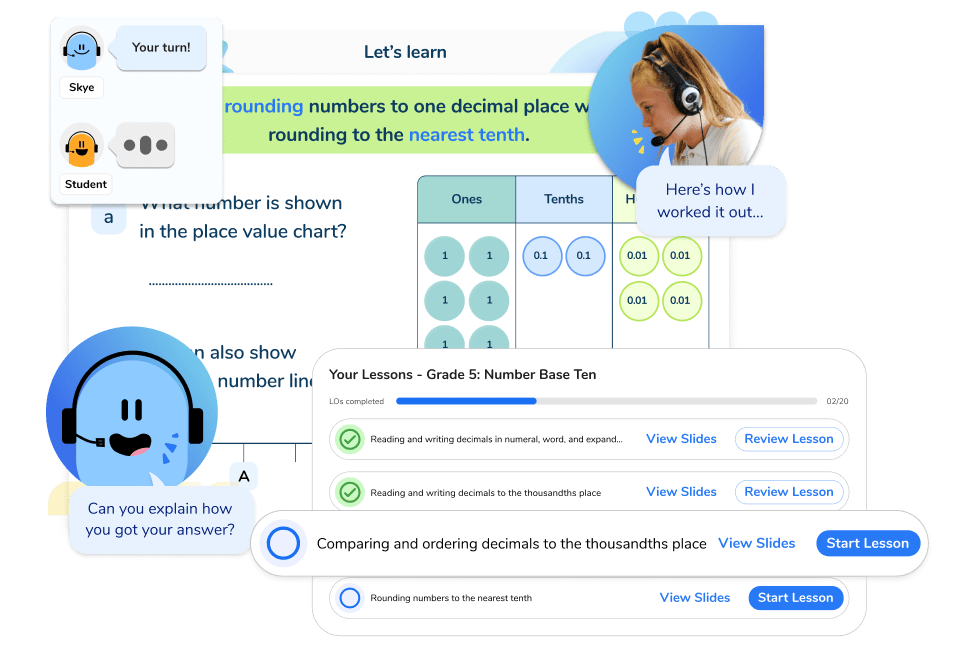Online math tutoring programs trusted by schools
Address gaps at scale with standards-aligned one-on-one AI math tutoring

“We needed to give extra instruction for certain students. With Third Space Learning, 24 of our students are learning math one-on-one at once. We would never have the amount of resources to be able to do that in house. Out of everyone who has taken part in the math tutoring, everyone’s scores have increased and they’ve said they have a better understanding of math.”

Liz Avery, Math Instructional Coach
Renaissance Academy Charter School, New York
How AI math tutoring works in schools and districts like yours

1 Add students: unlimited students for one low fixed cost
2 Schedule: choose session length, dosage & start time
3 Select programs: sets the math concepts students learn
4 Lesson order: choose the default or re-order at any point
5 Scheduled tutoring: students listen and talk as they learn
6 Personalize learning: assessments help Skye adapt lesson pace
7 Ad-hoc tutoring: on-demand tutoring outside your schedule
8 Monitor progress: real-time reports keep you up-to-date

One-on-one math tutoring that reaches more students
With busy classes, stretched workloads and limited budgets, it’s often impossible to give personalized support to every student who needs extra help to achieve grade level success.
Since 2013, over 4,100 schools and districts have chosen Third Space Learning’s cost-effective one-on-one math tutoring – giving them more time to focus on Tier 1 classroom support.
We’ve used all the online tutoring insights we’ve gained in the last decade to create Skye, an AI math tutor like no other.

A high-quality, low-cost AI math tutor for schools
Math tutoring should go beyond asking questions and grading answers, which is why we’ve built an AI math tutor that talks students through math problems as they listen and respond.
Math support from Skye replicates the tutoring experience and extensive knowledge of a specially trained math and pedagogy expert – but even more accessible for school and district budgets.
Online math tutoring from Skye is unlimited for one fixed low cost, so every student in your school who needs it can develop their math skills with their own personal math tutor.
Meet Skye, the AI math tutorProven impact on confidence and academic progress
Students make 2x expected math growth
90% of teachers say the math tutoring leads to higher test scores
Students are engaged in 90% of math tutoring sessions
70% of low-confidence students say they feel confident after learning with Skye
“As administrators, we’re always looking for that silver bullet. Third Space Learning’s AI math tutoring programs are pretty close! I was excited that it wasn’t text-based AI but spoken word. I liked that the kids could explain their thinking.”

Ryan Lucas, Principal
Governor’s Ranch Elementary, Colorado
Flexible use across the school and district

With Third Space Learning’s low-cost math tutoring programs, schools can support multiple students in multiple different ways.
Students can attend scheduled tutoring sessions as part of their WIN or intervention block, or attend on-demand sessions to work through particular math concepts, when you’re short staffed, or to prepare students for upcoming assessments.
Because there are no per-session fees, you can use the tutoring programs whenever and wherever you need; at school or as part of your homework approach.
More like this…
Book a free math tutoring pilot for your school
Get in touch today to arrange a free pilot of AI math tutoring with Skye. After a quick call, we’ll set everything up so you can see how your students will benefit from high-dosage one-on-one math tutoring:
Trusted by more than 4,100 schools since 2013
Unlimited one-on-one tutoring for one low fixed cost
Developed by math teachers for maximum academic impact
Built using insights from 2.1 million math tutoring sessions in schools
Designed to improve math state assessment scores